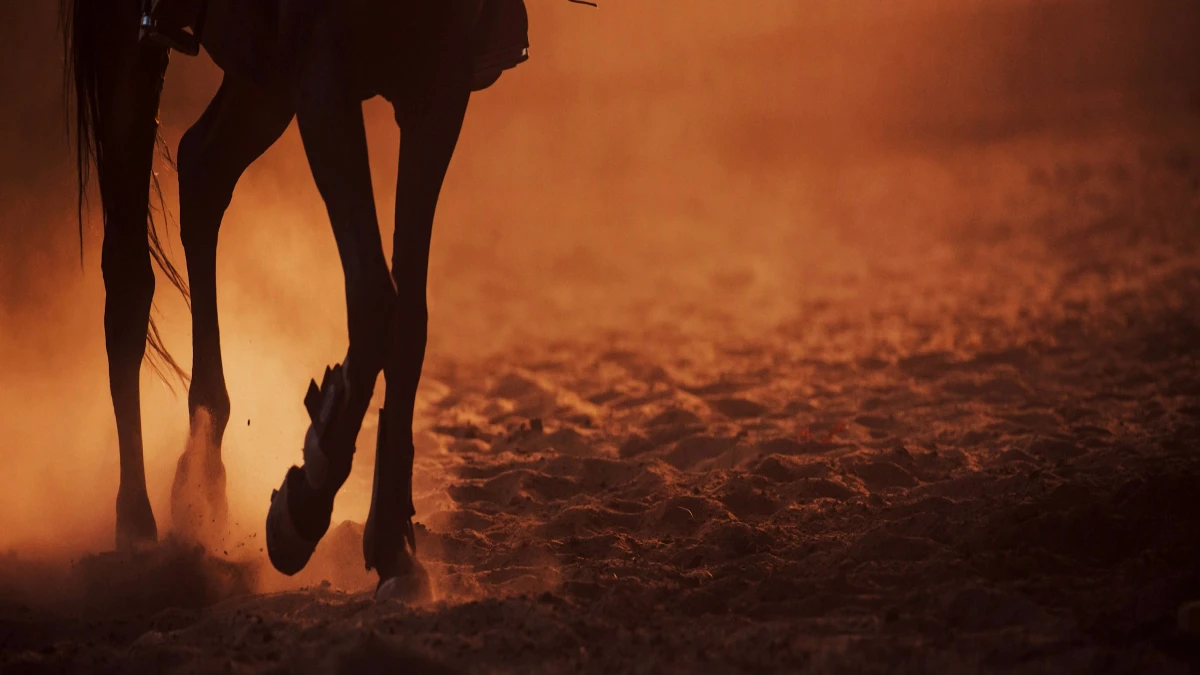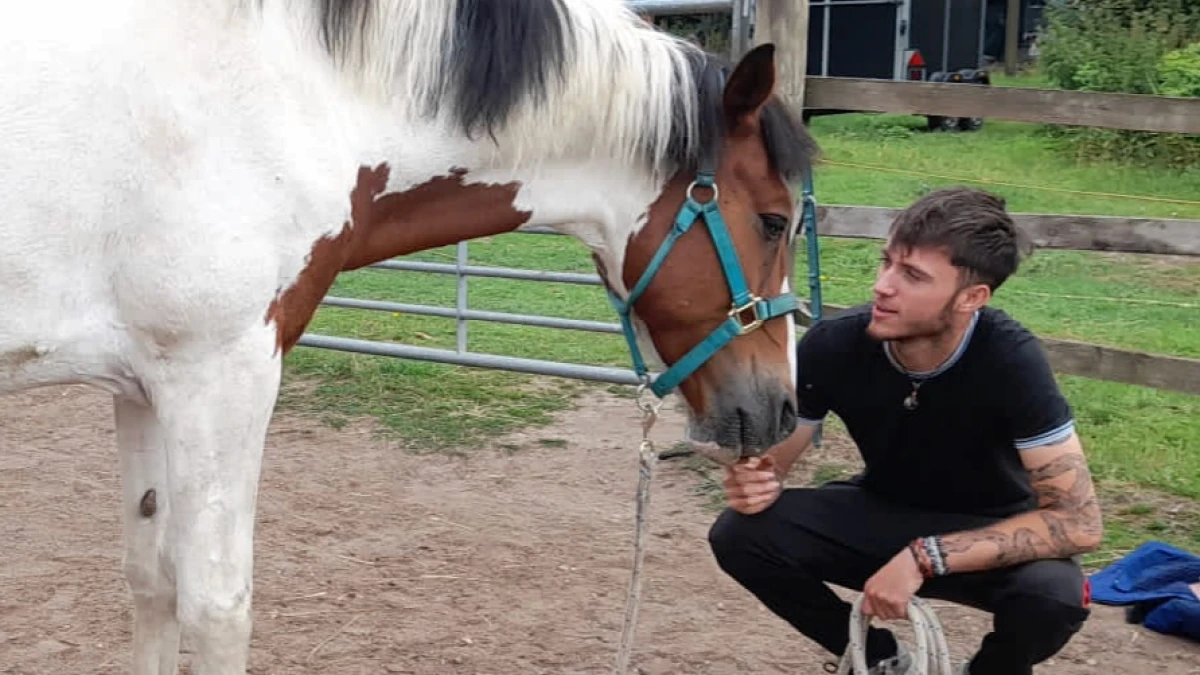10 Essential Groundwork Exercises to Improve Equine Agility
Oct 28, 2024 by Jamie Finch

Improving your horse's agility, coordination, and responsiveness through groundwork is essential for a well-rounded equine athlete.
These exercises foster physical fitness, mental engagement, and a deeper bond of trust, creating a solid foundation for any equestrian discipline.
Whether you're focused on improving your horse's manoeuvrability on the trail, in an arena, or through obstacles, these exercises progressively build the skills needed for a calm, confident, and agile partner.
Here are ten essential groundwork exercises to elevate your horse's agility, each with detailed steps and insights into their lasting benefits.
1. Leading with Precision
How To Do It:
Stand at your horse's shoulder, holding the lead rope lightly.
Ask your horse to walk forward with you, stopping together when you cue them to halt.
Practice stopping, turning, and leading over various surfaces and in different environments.
Why It's Important
This exercise develops the basic skills of following and responding to essential cues, which advances your horse's development.
By reinforcing a light, consistent cue, your horse learns to remain focused on you as their handler, even in different environments.
Precise leading establishes mutual respect, showing your horse that you provide guidance and security, which is essential for confidence and calmness, especially in unpredictable environments.
Agility Benefits
Precise leading develops your horse's awareness of your movements, so they know how you move, and you see how they move.
You change the movement to adapt to how your horse moves, and when there is a change, you know what movement to do next.
2. Yielding the Hindquarters
How To Do It:
Stand beside your horse's hindquarters, applying light pressure on their side.
Encourage them to step over with their hind legs while keeping their front legs stationary.
Repeat until they yield easily with minimal prompting.
Why It's Important
Disengaging the hindquarters strengthens your horse's leg muscles and core muscles and enhances overall body awareness.
This increases their flexibility and willingness to respond to pressure from multiple directions, which is beneficial for balanced and responsive movement when doing groundwork, agility work or ridden work.
Disengaging the hindquarters is known to give your horse calming effects, as it requires the horse to relax and focus on each step rather than moving forward impulsively.
Agility Benefits
This exercise will help sharpen your horse's ability to control and move their hindquarters, which helps when you ask your horse to move forward over obstacles, make tight turns and bend around small circles.
The lateral flexibility that your horse developed through the exercise enhances their ability to happily shift weight and manoeuvre their body, which overall builds the groundwork for more advanced agility exercises.
3. Backing Up on Cue
How To Do It:
Stand facing your horse and start walking toward them while using a verbal cue like "back."
If they don't respond, gently press on their chest while repeating the cue.
When your horse steps back, release the pressure and praise them.
Why It's Important
Asking your horse to back up on cue will improve their balance, overall coordination, and how they can engage their hindquarters.
Backing up encourages your horse to shift its weight and adjust its foot placement, which is an essential skill when your horse needs to move over obstacles carefully.
This movement also develops responsiveness, as your horse will begin to understand vocal cues, and these can be used in other groundwork exercises.
Agility Benefits
Backing up strengthens your horse's control over their hindquarters, allowing your horse to move through tight spaces and obstacles.
It can enhance agility by requiring your horse to think about each foot placement before they move their foot, which enables your horse to happily move through narrow paths.
4. Circle Work
How To Do It:
Stand in the centre and guide your horse to move in a circle around you on a long lead rope.
Maintain a steady pace and encourage a smooth rhythm, using gentle cues to keep them moving.
Change directions periodically to work both sides evenly.
Why It's Important
Circle work helps your horse develop balance, rhythm, and relaxation while building fitness in a low-stress way.
Encouraging your horse to change their bend and the placement of their legs on the circle, both sides of the body are equally engaged, increasing the leg muscles and core muscles.
Agility Benefits
Balanced, controlled circle work prepares your horse to handle agility exercises involving quick turns and direction changes.
5. The Serpentine Pattern
How To Do It:
Set up cones or markers in a zig-zag or serpentine pattern.
Guide your horse to weave through the pattern at a consistent pace, encouraging smooth, gradual turns.
Start with wide loops and gradually tighten them as your horse becomes more comfortable.
Why It's Important
The serpentine pattern builds flexibility and coordination by asking your horse to change directions repeatedly and smoothly.
This type of bending work is essential for loosening muscles, particularly in the shoulders and hindquarters, allowing your horse to carry themselves more fluidly.
It also improves focus and engagement, as your horse must listen and respond to subtle cues.
Agility Benefits
Teaching your horse the serpentine pattern on the ground benefits groundwork, agility work and ridden work.
This exercise improves your horse's ability to handle sharp turns, which will help your horse navigate through agility courses where quick, fluid manoeuvres are crucial.
You'll see how your horse can change their movement and how they bend on the ground, allowing you to assess where you need more training before doing the agility course.
6. Ground Poles for Coordination
How To Do It:
Place one or more poles on the ground and lead your horse over them at a walk.
Encourage your horse to lift their feet carefully over each pole, paying attention to their steps.
Gradually increase the number or height of the poles to add complexity.
Why It's Important
By focusing on careful foot placement, ground poles help your horse develop better balance and proprioception, which are essential for managing obstacles.
Ground poles and raised poles are excellent for improving foot placement, leg muscles, and core muscles, as well as teaching your horse to be mindful of each step.
Agility Benefits
Ground poles and raised poles are effective ways to improve your horse's leg muscles and core muscle, as you encourage high leg movements for your horse to step over the poles.
The exercise also prepares your horse for varied terrain and unexpected obstacles, which builds their confidence and coordination.
7. Side-Passing Along a Fence
How To Do It:
Stand beside your horse and gently press near their withers or ribs to cue a sideways step.
Encourage them to move laterally along the fence without stepping forward.
Use vocal cues and reward each correct step to reinforce the movement.
Why It's Important
Side-passing helps your horse develop lateral flexibility and control, which are essential for more complex movements.
This exercise encourages your horse to respond to subtle pressures, engage different muscle groups and teaches patience and focus, as it requires controlled steps instead of your horse having impulsive forward movement.
Agility Benefits
Side-passing develops the precise lateral movement needed to navigate narrow spaces, which is essential for complex agility courses.
8. Obstacle Weaving
How To Do It:
Set up several cones or objects in a line.
Lead your horse through the objects in a weaving pattern, starting with wide gaps and narrowing them gradually.
If your horse struggles when you move the objects closer, make them wider and try the exercise again before you put the objects closer.
Use vocal encouragement and reward calm progress to build focus.
Why It's Important
When your horse weaves through the objects, trust is being built between you and your horse through vocal cues, which leads to a stronger bond being built.
Your horse will be able to develop their body control and awareness by turning to adjust where they are on the path to move around the objects.
Agility Benefits
Weaving teaches your horse to make quick, controlled turns, which is essential for agility courses where obstacles are close together.
9. Desensitisation Drills
How To Do It:
Introduce new or unfamiliar objects, such as tarps or bags, in your training area.
Allow your horse to investigate each item at their own pace, reassuring them as needed.
Reward calm behaviour to reinforce trust and confidence.
Why It's Important
Desensitisation builds mental resilience, teaching your horse to handle surprises calmly and by exposing them to various objects you help reduce your horse's fear and skittishness, which creates a reliable, adaptable horse.
Agility Benefits
A desensitised horse is less likely to spook in agility courses, where they may encounter unexpected obstacles, allowing them to focus on the course rather than on external stimuli.
During an agility course, there are several objects your horse may spook at, so by exposing them to as many objects as you can helps them become more calm during the agility course.
Use agility training objects, or desensitising objects such as tarpaulin or cones at home when you are training, to prevent the spooks on the course.
All training is essential and there is never a guarantee that your horse will not spook, but the more your can show them, the more calm they will be if they do see an object that spooks them, and they may be able to ignore the object as it is something they have already seen before.
10. The "Squeeze" Between Objects
How To Do It:
Set up two objects a few feet apart, creating a narrow pathway.
Guide your horse through the gap, rewarding them as they calmly pass through.
Gradually decrease the width of the gap as they grow more comfortable.
Why It's Important
When you help your horse through the space, your horse will need to trust you more.
This will help with other exercises, as when you ask them to do something they're not sure of, they will trust you, making them more willing to go through or past something new like a tight space.
You will be building trust and helping your horse overcome any fear of tight spaces and teaches spatial awareness, as your horse must navigate with precision.
Agility Benefits
Your horse gains the mental and physical skills needed for tight navigation, ultimately boosting confidence and precision.
Horse agility requires trust, and by practising taking your horse through tight spaces at home, you have begun building your horse's trust for you.
Having your horse trust you as you move forward through the agility course, will have an impact on how you do.
It will be clear if your horse trusts you, as they will be willing to go through tight spaces on the course.
More trust always means more Positive impacts on agility courses.
Conclusion
Each groundwork exercise in this guide develops specific skills crucial for a well-rounded, agile equine partner.
The more you do during training, the better your horse will be on the course.
These exercises will help your horse move confidently, adapt to new challenges, and become a reliable and agile partner both in and out of the arena.
Use the exercise to practice horse agility, strengthen your bond with your horse on the ground, and refresh you and your horse's knowledge on groundwork exercises that can be helpful for building bonds riding.
All of these exercises will be more effective when practised regularly for about 10 minutes a time per exercise.
Explore More Topics
Understanding Behavioural Changes in Horses
When a horse’s behaviour suddenly changes, it’s rarely without cause. This blog explores the physical, emotional, and environmental reasons behind behavioural shifts — and how owners can respond with understanding, clarity, and care.
May 31, 2025
Top Tips for First-Time Horse Owners: How Equine Insurance Can Give You Peace of Mind
Equine insurance is a crucial safety net for horse owners, providing financial protection against unexpected costs related to veterinary care, accidents, injuries, and liability claims. Whether you're a first-time owner or an experienced equestrian, insuring your horse offers peace of mind by covering expensive vet bills, public liability issues, theft, and even death.
Oct 23, 2024
The Importance of Groundwork: Building Trust and Communication with Your Horse
This article explores the importance of groundwork in building trust and communication between horse and rider. It covers the basics of groundwork, explains how it strengthens the horse’s confidence and respect, and offers key exercises such as leading, desensitisation, and lunging. The article also highlights the role of body language and how groundwork prepares horses for ridden work, improving safety, focus, and obedience.
Sep 10, 2024







